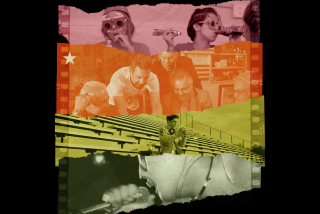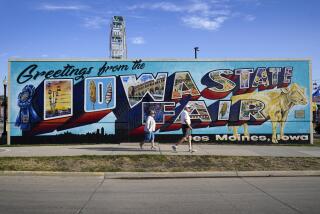From Pig Hunting to Models, the Tejon Is Quite a Ranch
- Share via
LEBEC, Calif. — The fancy cars and motor homes rolled past the gate and onto the ranch, one after another, carrying models, photographers and makeup artists en route to a golden meadow, illuminated by the rising sun.
It was indeed a glorious day for a fashion shoot, just as it was for the annual Pig-o-Rama, an entirely different type of shooting event attracting an entirely different crowd.
For the last several years, wild pigs have been running amok on vast and historic Tejon Ranch, just as the film crew was doing on this fine, bright December morning.
“These people are driving way too fast through here, stirring up all kinds of dust,” one pig hunter bemoaned from behind the wheel of a dirt-covered Jeep. “They have no consideration. The animals are probably running for the hills.”
The dust caused by a meadow-bound silver Mercedes had just settled when game manager Don Geivet pulled alongside the Jeep. He acknowledged the complaint and assured the hunter that he’d clue those people in as to what else was happening on ranch property.
“This is a clash [of user groups] that we try to avoid,” Geivet said as he continued down the road. “And had the gal that runs the filming operation talked to me first, they would not be doing this [fashion] shoot today.”
Yet shoot they did, the photographers and the hunters, and when the dust had settled on the day, things seem to have gone reasonably well for everyone but a few dozen pigs.
Proudly presenting a large Russian-strain boar, a mostly black specimen with a rust-colored coat, was Jeff Worden, 43, of Riverside. Worden looked as though he had been through a war, and with coarse stubble on his jowls and slits for eyes, he removed the cigarette from between his lips and explained that, in a way, he had been.
The pig he shot at dawn’s first light, with a .270-caliber rifle from more than 300 yards, atop a ridge across a steep canyon, took several bullets to bring down and when it went, it went all the way--rolling another 300 yards to the bottom of the canyon.
Worden said it took four hours to reach the beast, tie it to a rope and guide it back up the hillside as it was being towed by a truck driven by his hunting partner, Chuck Hane.
“It took all 1,200 feet of rope,” Worden said, sighing when his pig registered a dressed-out weight of only 181 pounds. It was a fair-sized animal, but it was one pound shy of the one Hane had killed a day earlier, and Hane’s broad smile was an indication that he didn’t care so much about winning the event, so long as he bettered his friend.
Later that day, a 230-pound sow was checked in, easily out-weighing all others. And by the end of the three-day event, 146 hunters who’d shelled out $300 apiece, had removed 50 of the wild pigs. Though Geivet, from a management standpoint, would have liked seeing more pigs killed, it was only a slightly smaller success rate than he had expected.
“Our deal is a little different than most of the pig hunting in California,” he said. “Those animals [in other areas] are mostly eating grain crops and they always return to those crops. Here, they’re free-ranging and go where they want and do what they do, and there’s no focal food point to bring them back. Here, you actually have to go and hunt them, so in that regard it’s more challenging.”
Especially during a fashion shoot.
*
Tejon Ranch, long known for its expansive cattle-raising and farming operations, has also long been regarded as a paradise for sportsmen.
And, yes, with its sprawling western landscape, it has long been a popular location for movie shoots and photography.
Situated 60 miles north of Los Angeles along Interstate 5, the ranch is about 40 miles long and 35 miles wide, and within its 272,000 acres of rolling hills and steep, forested canyons, are not only livestock and wild pigs, but Rocky Mountain elk, mule deer, pronghorn antelope, wild turkeys, bobcats, bears and mountain lions.
Hunters are treated to “a unique and quality experience,” Geivet said, through a membership system that enables seasonal hunts for different animals, and combinations for some. They range in price, from $11,000 for a guided bull elk hunt to $500 for an unguided pig hunt.
The ranch operates under a Wildlife Area Management License issued by the state, which enables concessions on statewide season dates. Tejon Ranch, for example, is within the D10 deer zone, but its hunting dates don’t entirely match those in the zone.
Overnight hunts on the ranch include lodging in one of two large cabins with full kitchens and fireplaces, boasting spectacular views of and well beyond ranch property.
The cabins are totally remote and guests are often treated to sightings of raccoons, deer, red foxes and even antelope. The sound of elk bugling in the distance is a special treat but not necessarily a rare one, Geivet said.
Also on the ranch is a large lake teeming with trophy-size largemouth bass, and for an annual fee of $1,000, anglers have unlimited use of boats and can fish as often as they like.
As for the Pig-o-Rama, it’s a special event that doesn’t require memberships, held each year simply to help keep the feral animals from overrunning the place.
“Pigs are so prolific that the only defense you have is to [kill them],” Geivet said, adding that sows generally have two litters a year but can have as many as three, and from each, four or five piglets reach maturity. There are more than 2,000 pigs on the ranch.
You don’t always see them, but you see where they’ve been. Deer and other animals leave narrow, barely visible game trails angling up or down a hillside, but pigs plow straight up and straight down, uprooting vegetation along the way.
“The pigs are in competition with not only the grazing cattle, but with deer and other animals because they like the same things to eat, like acorns, and they root up all the grassland,” said Darrell Francis, 68, a hunting guide with 40 years’ experience here.
Francis explained that pigs were never part of the game plan, but were introduced inadvertently about eight years ago by a nearby rancher who used to offer enclosed hunts for Russian-strain pigs he had put on his property.
A few apparently got through the fence, expanded their range, and now they can often be seen traveling around in family groups that most commonly include three to five mature sows and 15 to 20 juvenile pigs, and perhaps a small boar or two. The larger boars--they reach a live weight of about 350 pounds--tend to travel solo.
Rooting as they go, the pigs are opportunistic and will eat almost anything they turn up, from insects and grubs to small snakes. Using sharp tusks, they also plow through the nests of burrowing birds, slurping up eggs.
As destructive as they are, however, they are also a challenging game animal and attract more hunters every year, so in that regard the ranch is happy to have them.
“It’s a wonderful animal on the table and it’s both intelligent and very powerful,” Francis said from his post at the gate-side scale, rubbing his hands as a brisk breeze developed. “They’re very nervous and always on the move. Deer are usually calm unless they’re spooked, but these pigs are moving all the time. And you don’t want to corner one, especially a wounded one because then it will hunt you.”
Francis proudly displayed a large scar on his hand, the result of a wound from the tusk of a dead pig that slipped from his grasp after it had been killed.
“I took 19 stitches,” he said.
He then told of a bow hunter who was badly injured by a large boar that charged him after the arrow had failed to do its job.
“He had three compound fractures in his leg and his knee was shattered,” Francis said. “His leg and his arm were slashed by the animal’s tusk. You never saw such a mess. He would have died had his friend not been there to help him.”
Francis relishes his time spent on the ranch and loves to share stories about his days in the field. When told of the shot by Worden at 300-plus yards, he whispered, “That’s way too far” and explained that a responsible hunter ought to be much closer before pulling the trigger, to ensure a well-placed shot so the ranch doesn’t have a wounded pig in its midst.
Asked how close hunters can get, Francis quietly bragged, “I’ve touched them. It’s a dangerous thing to do and it requires a lot of stalking and sneaking through the grass, but I’ve done it. I have actually poked them with my rifle.”
On this day he was simply weighing them at the scale inside the gate, getting strange looks from the models in their fancy cars, finding it amusingly ironic that a fashion shoot and Pig-o-Rama were being held here on the same day.
“I’m not sure we should be weighing these things right here in front of them like this,” he said as he hoisted up a small black boar, while the woman in the Mercedes stole a curious peek. “I wonder what she’s thinking right now. I wonder if she even knows what this animal is.”
*
* FISH, SKI REPORT: D12
More to Read
Sign up for The Wild
We’ll help you find the best places to hike, bike and run, as well as the perfect silent spots for meditation and yoga.
You may occasionally receive promotional content from the Los Angeles Times.






